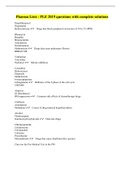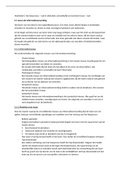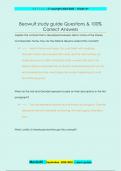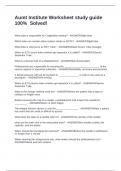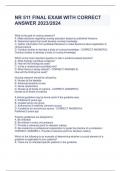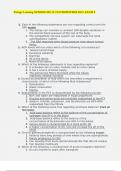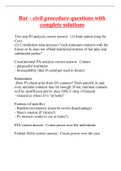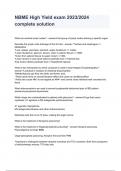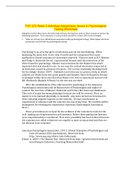Sheetnotes Human Resource
Management
Lecture 1: HRM in the 21st Century
If you do not aspire working in human resource management, this knowledge can still be used in
business consultancy and other managerial positions etc.
SHRM society of human resource management largest community in the world. A lot of
information on website. SHRM offers certifications programs HRCI.
Introduction to HRM
HRM: history and the present
Case of today—Starbucks
- 3000 locations
- Aim: one Starbucks at every corner
- A lot of employees if want to replace a whole city of Groningen cannot suffice
- Rated very high in employees
- Turnover rate (leaving of employees): only 17% average is 150-400%.
The history of HRM
- 1930: Taylorism and scientific management
o History of management
o In order to get workers to finish their jobs you need to exert a strict control on them,
make sure workers can finish their job on time
o No prober idea of human resource management, personnel management
o Employees did not engage at work, did not show up not efficiently
- 1930-1960: Personnel management (question: difference with Taylorism?)
o Managers had to make sure that employees work productively
How fast can employees can do their task?
How is the quality of what they deliver?
o People come to work, work in sufficient way to ensure efficacy an efficiency
quantity of product employees can produce
- 1960 Human resource management
o Cost-centered HRM is there to reduce the costs make sure that employees do
not become lazy or do not deliver changed
o New idea psychologists: employees are human recognize they have
motivations, needs, social needs motivate them with different approaches:
recognition, great work environment, money
- 1970-: Strategic human resource management
o Should be aligned with corporate strategies
M in HRM
Traditional HRM aimed for:
- Task completion; absenteeism; turnover (is accompanied with a lot of financial but also
social costs)
,Key outcomes now:
- Improve performance & productivity (effectiveness + efficiency)
- Achieve organizational goals
- Help employees prosper (e.g. engagement)
o Finding own value
o Developing competence skills
o Enjoy their own job
- Stimulate positive behaviors
o Extra roll behavior
- Fulfill social responsibilities
R in HRM
Employees as resources:
- Economic resources
o Knowledge, skills & abilities will help achieve your work, get things done
- Intangible assets
o Creativity & social capitals employees carry other valuable assets with them
o When you hire people, particularly senior management, you also hire the network of
the person
o Creativity and innovation extra rol behavior not defined by contract can
provide something valuable and innovative competitive advantage
- Varying asset values
o Star vs non-star employees
E.g. john leahy airbus increased market share in airplane industry
star-leader, star performance can contribute to your firm performance
20% of the employee population 80% the performance
o Ups and downs of employees
they are human
family situations: maternity leave
understanding health, varying value in terms of resources more
humanistic caring system to employees
H in HRM
- Human needs
o Self-determination theory
Autonomy: we want to master our own lives, make our own choices
Competence: demonstrate competence
Relatedness: social connections
- Motivation and emotions
o Maslow’s motivation hierarchy
- Employee wellbeing
o Stress burnout satisfaction
o Issues of engagement is overwhelming: 13% really feel engaged at work
o High pace stress
- Life beyond work!
o Security and health, wellbeing, work-life balance
o E.g. policies for children to go to local schools
,An example of Starbucks
HR policies
- Employees as partners
- Respecting them as people, valuing them as people
HR systems
- Compensation structure
- Partners should have better salary than workers
HR practices:
- Salaries above minimum wage
- College Achievement Plan, Coffee master program
- Open forums with senior management opportunity to growth from first line
Essential HRM functions
What kind of resources do you need planning how many people, what do they need to do etc?
HR forecasting: what would be the supply, demand combined with job analysis what kind
of competence? Analyzing your work flow, analyzing your jobs
How do I find them? Hiring attract sufficient amount of employees, selection process, the best,
fit your company
How do we manage them? HR assessment and training we want certain outputs from them
check their performance, mental health, develop trainings motivation incentives, different
approaches
Evidence-based HRM!
Intuition-based or evidence-based?
- The most valid performance interviews are designed around each candidate’s unique
background. True or false?
o Structured interviews with same questions has higher validity than unstructured,
meaning that the statement is false.
o Different questions how can you compare? How can you be unbiased?
- HR Professionals: Average of 57 % correct answers out of 39 questions
, HRM: new challenges
New HRM challenges(1): Globalization
Reasons
- Lower costs (but can lower job opportunities in home country)
- Companies would like to expand
- Countries due to political negotiation would agree to low the barrier stimulate
globalization
Examples:
- Offshoring: the practice of basing some of a company's processes or services overseas, so as
to take advantage of lower costs.
- Outsourcing: is a business practice in which services or job functions are farmed out to a
third party.
- Reshoring: the practice of transferring a business operation that was moved overseas back
to the country from which it was originally relocated.
Starbucks, benefits from offshoring latin-american countries, such as Colombia coffee beans
uk for production and selling. Subsidiary in Switzerland manages this relationship 20% increase
in return for this uk can benefit from this tax-refund policy gain more via setting up very tiny
offers in Switzerland
Outsourcing nothing to do with location, does not matter which country the organization is in
ownership of certain businesses has shifted from your own company to somewhere else for
example when you want to focus on most important business operations. E.g. starbucks realized that
the benefit of producing your own coffee beans was no longer that high than selling them
revenues more from selling part than from production part shut down its manufacturer in Seattle
70% of coffee beans from all sorts of local workshops, factories in Africa, Asia.
Criticism bring back more to home country reshoring for example when labour force in
China getting more and more expensive
Global Organization: An organization that employs a workforce in different countries throughout the
world, with a view to maximizing performance by sourcing or providing goods and/or services in a
globally based market, and in which decisions are driven by markets rather than geography
Global Participation and global employees can be classified into three groups
- Parent/home country: the country in which the company's corporate headquarters is
located.
o Parent-country nationals
- Host country: the country in which the parent country organization seeks to locate (or has
already located) a facility.
o Host-country nationals
o Move manufacturer to Colombia, employees that you hire there
- Third country: a country other than the host country or parent country. A company may, but
is less likely, to have a facility there.
o Third-country nationals
In which countries do you anticipate an increase in assignment volume over the next 5 years?
Management
Lecture 1: HRM in the 21st Century
If you do not aspire working in human resource management, this knowledge can still be used in
business consultancy and other managerial positions etc.
SHRM society of human resource management largest community in the world. A lot of
information on website. SHRM offers certifications programs HRCI.
Introduction to HRM
HRM: history and the present
Case of today—Starbucks
- 3000 locations
- Aim: one Starbucks at every corner
- A lot of employees if want to replace a whole city of Groningen cannot suffice
- Rated very high in employees
- Turnover rate (leaving of employees): only 17% average is 150-400%.
The history of HRM
- 1930: Taylorism and scientific management
o History of management
o In order to get workers to finish their jobs you need to exert a strict control on them,
make sure workers can finish their job on time
o No prober idea of human resource management, personnel management
o Employees did not engage at work, did not show up not efficiently
- 1930-1960: Personnel management (question: difference with Taylorism?)
o Managers had to make sure that employees work productively
How fast can employees can do their task?
How is the quality of what they deliver?
o People come to work, work in sufficient way to ensure efficacy an efficiency
quantity of product employees can produce
- 1960 Human resource management
o Cost-centered HRM is there to reduce the costs make sure that employees do
not become lazy or do not deliver changed
o New idea psychologists: employees are human recognize they have
motivations, needs, social needs motivate them with different approaches:
recognition, great work environment, money
- 1970-: Strategic human resource management
o Should be aligned with corporate strategies
M in HRM
Traditional HRM aimed for:
- Task completion; absenteeism; turnover (is accompanied with a lot of financial but also
social costs)
,Key outcomes now:
- Improve performance & productivity (effectiveness + efficiency)
- Achieve organizational goals
- Help employees prosper (e.g. engagement)
o Finding own value
o Developing competence skills
o Enjoy their own job
- Stimulate positive behaviors
o Extra roll behavior
- Fulfill social responsibilities
R in HRM
Employees as resources:
- Economic resources
o Knowledge, skills & abilities will help achieve your work, get things done
- Intangible assets
o Creativity & social capitals employees carry other valuable assets with them
o When you hire people, particularly senior management, you also hire the network of
the person
o Creativity and innovation extra rol behavior not defined by contract can
provide something valuable and innovative competitive advantage
- Varying asset values
o Star vs non-star employees
E.g. john leahy airbus increased market share in airplane industry
star-leader, star performance can contribute to your firm performance
20% of the employee population 80% the performance
o Ups and downs of employees
they are human
family situations: maternity leave
understanding health, varying value in terms of resources more
humanistic caring system to employees
H in HRM
- Human needs
o Self-determination theory
Autonomy: we want to master our own lives, make our own choices
Competence: demonstrate competence
Relatedness: social connections
- Motivation and emotions
o Maslow’s motivation hierarchy
- Employee wellbeing
o Stress burnout satisfaction
o Issues of engagement is overwhelming: 13% really feel engaged at work
o High pace stress
- Life beyond work!
o Security and health, wellbeing, work-life balance
o E.g. policies for children to go to local schools
,An example of Starbucks
HR policies
- Employees as partners
- Respecting them as people, valuing them as people
HR systems
- Compensation structure
- Partners should have better salary than workers
HR practices:
- Salaries above minimum wage
- College Achievement Plan, Coffee master program
- Open forums with senior management opportunity to growth from first line
Essential HRM functions
What kind of resources do you need planning how many people, what do they need to do etc?
HR forecasting: what would be the supply, demand combined with job analysis what kind
of competence? Analyzing your work flow, analyzing your jobs
How do I find them? Hiring attract sufficient amount of employees, selection process, the best,
fit your company
How do we manage them? HR assessment and training we want certain outputs from them
check their performance, mental health, develop trainings motivation incentives, different
approaches
Evidence-based HRM!
Intuition-based or evidence-based?
- The most valid performance interviews are designed around each candidate’s unique
background. True or false?
o Structured interviews with same questions has higher validity than unstructured,
meaning that the statement is false.
o Different questions how can you compare? How can you be unbiased?
- HR Professionals: Average of 57 % correct answers out of 39 questions
, HRM: new challenges
New HRM challenges(1): Globalization
Reasons
- Lower costs (but can lower job opportunities in home country)
- Companies would like to expand
- Countries due to political negotiation would agree to low the barrier stimulate
globalization
Examples:
- Offshoring: the practice of basing some of a company's processes or services overseas, so as
to take advantage of lower costs.
- Outsourcing: is a business practice in which services or job functions are farmed out to a
third party.
- Reshoring: the practice of transferring a business operation that was moved overseas back
to the country from which it was originally relocated.
Starbucks, benefits from offshoring latin-american countries, such as Colombia coffee beans
uk for production and selling. Subsidiary in Switzerland manages this relationship 20% increase
in return for this uk can benefit from this tax-refund policy gain more via setting up very tiny
offers in Switzerland
Outsourcing nothing to do with location, does not matter which country the organization is in
ownership of certain businesses has shifted from your own company to somewhere else for
example when you want to focus on most important business operations. E.g. starbucks realized that
the benefit of producing your own coffee beans was no longer that high than selling them
revenues more from selling part than from production part shut down its manufacturer in Seattle
70% of coffee beans from all sorts of local workshops, factories in Africa, Asia.
Criticism bring back more to home country reshoring for example when labour force in
China getting more and more expensive
Global Organization: An organization that employs a workforce in different countries throughout the
world, with a view to maximizing performance by sourcing or providing goods and/or services in a
globally based market, and in which decisions are driven by markets rather than geography
Global Participation and global employees can be classified into three groups
- Parent/home country: the country in which the company's corporate headquarters is
located.
o Parent-country nationals
- Host country: the country in which the parent country organization seeks to locate (or has
already located) a facility.
o Host-country nationals
o Move manufacturer to Colombia, employees that you hire there
- Third country: a country other than the host country or parent country. A company may, but
is less likely, to have a facility there.
o Third-country nationals
In which countries do you anticipate an increase in assignment volume over the next 5 years?

